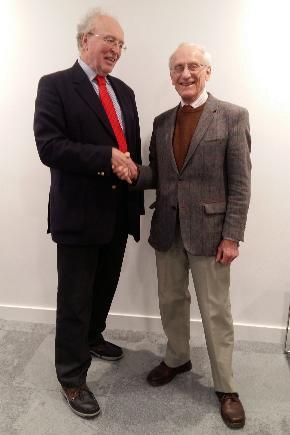SSEM (Baby) reconstruction
Chris has been responsible since 1994 as initiator and team leader for the
astonishingly detailed and ambitious pioneering project to reconstruct
the authentic full-size fully working replica of the Small-Scale Experimental
Machine (‘SSEM’) nicknamed “Baby”, the original
of which first ran a program in 1948.
The importance of the original computer, conceived and built at Manchester,
is that it was the world’s first stored-program electronic digital computer,
containing all the basic elements from which modern electronic computers have developed.
The reconstruction of the SSEM Baby remains the most influential of
all the influential computer reconstruction and restoration projects,
and illustrates the fundamental importance of UK computing in computer history.
This reconstruction was a world-first.
It was ambitious and unprecedented in scale and its successful completion
set the standard for other such projects in terms of technical and historical authenticity.
It demonstrated that such a project:
- was possible and achievable,
- was invaluable historically, and
- has substantial social and public value.
Following the successful reconstruction, the SSEM Baby replica first went
on public display in what is now the Science and Industry Museum in Manchester,
part of the Science Museum group, in June 1998, the centrepiece in a 50th
Anniversary celebration.
Ever since then, a team of 20 volunteers, under Chris Burton’s continuing
inspirational leadership, maintains the Baby as an authentic working
electronic computer and provides demonstrations to large crowds visiting the Museum.
Hundreds of visitors attend its demonstrations every week and several thousand
people have seen the static display.
Hand-outs are available in four languages.
It remains the most-visited pre-1950s working stored-program computer anywhere in the world.
There are normally at least three visits from school and college groups every week.
Well over a thousand school/college groups have been given talks on the Baby.
Now there are others engaged in computer restorations and reconstructions.
But it was Chris Burton’s ‘Baby’ reconstruction project that
was the first to be successfully completed.
This was a major staging post in proving that projects on this scale were achievable.
Founder member of the Computer Conservation Society (CCS), 1989 to present
Chris Burton has been a key member of the CCS throughout the years since it
was founded in 1989 – celebrating its 30th anniversary this year.
His advice to Officers, to Project Leaders, and to other members
of the Committee on computer conservation, whether on strategic issues,
expertise on matters of restoration or reconstruction, or administrative concerns,
is always considered, sensible, practical and helpful.
